
Anglers won’t find better postspawn bass fishing during May than this Roanoke River lake and its woody structure.
Lake Gaston is arguably one of the best lakes in North Carolina on which to fish for spawning bass. It’s big, full of fish, the kinds of little pockets and coves with stumps that attract spawners, and the water level is stable, which keeps fish on the beds for a longer period of time.
So is Gaston also one of the state’s best postspawn lakes?
Veteran bass fishermen Joe Nichols of Ahoskie and Marty Stone of Linden, who have fished the lake for years, are convinced it’s one of the state’s best spring bass holes.
Gaston is the closest major reservoir to Nichols’ northeastern North Carolina home, and he’s fished the lake as part of a handful of different pro bass circuits during the years.
Stone, a pro fisherman who has qualified for a handful of Bassmasters Classics, guided at Gaston for years before he took the pro-bass plunge.
Their verdicts are that bass anglers can have great days at Gaston during May, even with most of the lake’s largemouths in some stage of recovery from the spawn.
“You know, it’s a great time to fish,” said Stone, who was runner-up for the BASS Angler of the Year award during 2005. “The fish don’t like to get out (deep) early, and the shallow-water fishing should be good until the last week of the month.
“There are so many bass, they don’t mind biting during the post-spawn period, and they don’t move out entirely until early June.”
Nichols supported Stone’s assessment.
“It’s pretty easy in May,” he said. “You just fish shallow unless you’re comfortable fishing deep with a Carolina rig — but that’s unnecessary. What’s the purpose of going out deep when you can catch them shallow?”
Two aspects work together to hold Gaston’s bass in the shallows — thousands of boat docks and the aquatic grass that grows in skinny water around the lake — that and stumps and shad. Actually, many reasons exist as to why the 20,500-acre reservoir’s shallow regions will be full of fish.
However, the spawn, the two anglers said, will be limited to the extreme upper section of the lake.
Nichols said a few spawning fish can be found at the first of May in Holly Grove of Sixpound creek. Meanwhile, Stone said main-lake pockets at those areas and upstream from the I-85 and Rt. 1 bridges also will hold some bedding fish.
But the action is hit or miss, Stone said.
“You either hit a home run or dribble into a double play,” he said.
Like most bass anglers, Stone figures he’s got a better chance, day-in and day-out, to catch post-spawn fish at the lower end of the lake, especially from the Eaton’s Ferry Bridge area to the dam. There are more fish at the lower end, and the habitat is perfect — better for bass that are more interested in moving horizontally than vertically in May.
“From Eaton’s Ferry, the spawn is done during May, except for a few main-lake pockets,” Nichols said. “There’ll still be a few spawning at the upper end, especially if you want to go into some of the smaller cuts off the main lake. And it’s possible to have a few prespawn fish left up in the river.
“I run some of the little pockets, and if you don’t see ’em there, there’s no reason to go to the back end of any of the little creeks.
“If it’s a cloudy, windy or overcast day, you can fish a
G-Splash or a walking bait such as a Sammy and catch a big sack in the first hour,” Stone said. “If it’s a bright, sunny day, you can take a Trick Worm and cast to stumps or flats outside spawning pockets, or you can pitch docks.”
So it becomes a matter of looking at the lower end, trying to determine where the spawn has been finished long enough for bass to be at least partially recovered and feeding again. Then an angler must figure out where bass are staging on their way out of pockets and spawning flats to the creeks and main lake.
“It’s all about knowing where they’re coming out of,” said Stone, who targets three specific kinds of areas and forms of cover the week or two after the spawn has passed. “I will look at boat docks — the first two or three going back in a pocket and coming back out. I’ll also look for stumps coming out of pockets and look at the flats at the mouth of spawning pockets.
“This is the time that fish are moving horizontally — out of the pockets — but not vertically. They have to feed up before they move deep for the summer.”
Fishing docks is one of Nichols’ favorite pastimes at Gaston. He absolutely loves to pitch a bait underneath these platform, around the corner posts and even underneath the walkways of docks and piers just outside spawning pockets.
“When you’re fishing boat docks, you’re looking for the dark (shady) spots back up under them,” Nichols said. “I like the docks that are on flat banks. And they’re much better on sunny days.
“I think after the spawn they’re in a little bit of a funk, so a bait with a slower fall will get them.
“I like to fish a Senko or a trick worm — something that will fall real slow. You can Texas-rig a Trick Worm with a little weight, even fish it with a spinning rod.
“(Bass) like shad, and I think sometimes fishing up against the bank is better. You can skip a jig up under there to get to ’em, but what I really like to do is fish the walkway that comes off the bank out to the main platform of the dock. You can spend all day fishing a dock pattern, and the most aggressive fish will often be at the split where the walkway meets the platform. But don’t forget the ladder.”
When he fishes docks, Stone uses a Zoom Trick Worm, normally pegged on a 3/16-ounce tungsten T-Rig. He can pitch or flip the bait almost anywhere he wants on a dock, and he can count on a slow fall.
One of Stone’s favorite patterns is to fish shallow stumps at corners of spawning pockets or banks close to pockets. Most of the stumps will be in 3 to 4 feet of water, and he fishes them with a Senko rigged wacky style on a straight-shanked 3/0 or 4/0 worm hook, usually with 12- to 14-pound test monofilament main line.
“Some of your bigger fish will be at stumps,” Stone said. “They’ll get on stumps on the way in and the way out.
“And a lot of fish spawn on stumps or guard (fry) around stumps, which makes the Senko a lot better. The best stumps are the ones where you can just barely see under the surface; that’s where a lot of fish will set up.”
Flats at the mouths of spawning pockets are where topwater baits really start to be effective, Stone said. Nichols also likes to fish topwater lures near and above emerging aquatic vegetation.
“On the flats, bass will be spread out,” Stone said. “They’re not really ready for their migration out because the bait hasn’t moved out into deep water yet, and the (power) generation hasn’t cranked up yet like it will when the weather gets a lot warmer, and they start making electricity for everybody’s air conditioner. That’s what pulls those fish out.
“At this time of the year, all of the fish are feeding looking up,” Stone said. “That’s where a (Lucky Craft) G-Splash, a Sammy 110 or a Gunfish 115 really come in.
“On cloudy days, I like to use hard colors, colors you can’t see through, like the Aurora blacks. On sunny days, I use translucent colors — ghost minnow and clear laser shad. You just get out in front of the pockets and cast up on the flats. Those fish will move up and hit those baits.”
Nichols said bass will hold at bank grass or scattered patches of hydrilla that are just beginning to grow, and that’s where more topwater baits — buzzbaits in particular — come into play.
“You can fish a buzzbait along the edges of that bank grass or swim a jig through it,” he said. “I’ll fish any of it I can find. Some grows shallow, and some has deep water on the front side. If you get lucky and find some like that, you’ll have 2 1/2 or 3 feet of water on the front, and they can sit just inside the grass and ambush anything that comes by.”
Stone agreed.
“If you have a lot of bank grass up, that buzzbait bite can be real good,” he said.
Most of the hydrilla won’t emerge until Memorial Day approaches, said Nichols, who said the offshore grass will grow up one clump here, one clump there, acting almost like individual stumps as far as holding fish. That’s when he uses a Pop-R, a Trick Worm or a Senko.
“You fish the grass just like you’d fish a stump,” Nichols said. “By Memorial Day it will have grown up off the bottom enough to attract fish. It’ll be scattered in clumps, and fish will be all around it.”
The last great shallow-water bite typically occurs during late May, and it’s more associated with food than cover, Stone said.
“Another thing that happens at Gaston in May is the shad will spawn,” he said. “That’s when your popping baits like a G-Splash will really work.
“The shad will spawn on rip-rap or rocky banks, and they’ll also use those hard, clay banks. Gaston isn’t like Buggs Island; it doesn’t have enough ‘just rocks’ that all the shad can spawn on.
“You’ll get a lot of them at main-lake rocks; Gaston
doesn’t have the pretty corners that Buggs Island has; they’re more tapered. But the shad will get right up on the bank and spawn, and the bass will follow them right in. You have to cast right to the bank and pop the bait a couple of times.”
Prespawn, spawning or post-spawn, Gaston’s largemouth bass population continues to be excellent. Stone said anglers also shouldn’t even think about catching smaller bass.
“There are good, quality fish in that lake,” Stone said. “I’m looking at 2 1/2-, 2 3/4-pound fish and up — and don’t think you can’t catch a 6-, 7- or 8-pounder. You can consistently catch those 2 1/2- to 2 3/4-pound fish and up.
“These are the same fish that, in prespawn, your best five might weight 20 or 22 pounds. After the spawn, they’re a little skinny, but you can still weigh in five a day that will go 17 or 18 pounds.”
Gaston’s bass seem to be on the winning side in the battle over hydrilla. Owners of lakeside homes and government bodies have stocked grass carp in an attempt to curtail the spread of the aquatic grass, which is such good habitat for baitfish and largemouths that prey on them.
The lake’s homeowners association has contracted to have the hydrilla sprayed with chemicals in an attempt to control these cove-clogging plants.
“It’s a long battle,” Nichols said. “I just wish they wouldn’t spray it (with chemicals); I’d rather have the grass carp back.”

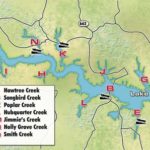
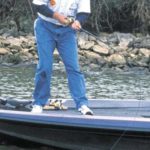
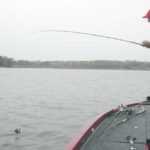
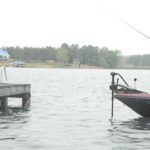
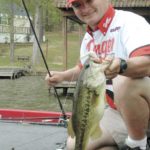
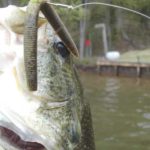
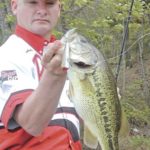



Be the first to comment